By Scott A. Mogull
ABSTRACT
Purpose: Technical video production in technical communication courses and practice have become increasingly prevalent with wider access to video equipment, software, and distribution technologies. The goal of this article is to provide a tutorial covering the writing genres used to develop well-planned informative, instructional, or persuasive videos.
Method: The process and genres in this article are developed from a comprehensive literature review as well as eight years of course development teaching advanced undergraduate and graduate courses on “technical video.”
Results: In this article, four genres for technical video planning and production are characterized, with examples, for industry practitioners, students, and instructors: video project proposal, storyboard, script, and shot list.
Conclusion: The four-genres used to develop technical videos in industry begins with video project proposal specifying the content, video style, delivery mode of the video, budget, and project timeline. The second step is to create a storyboard, a scene-by-scene sequence of drawings detailing the story or information planned for the video. Next, the process of writing the script develops from the storyboard outline to a more detailed visual and narrated script that emphasizes both the content and style. As covered in the article, video scriptwriting differs from other forms of technical writing—somewhat more similar to an oral presentation rather than print documentation. Furthermore, the narration of technical videos is more complex and often subordinate to the dynamic visual communication (which is, optimally, the primary mode of communicating information to the audience). Finally, the fourth genre to consider is the shot list, which takes the content directly from the script and reorganizes scenes and shots by location for the production staff in order to streamline the filming stage.
Keywords: Technical Video Genres (or “Templates”), Technical Video Project Proposal, Storyboard, Script, Shot List
Practitioner’s Takeaway:
- Genres of technical communication are conventionally organized by primary communication goal as informative, instructional, or persuasive. Using these three broad categories of technical communication based on type and style of information, this article identifies and characterizes nine specific categories of technical videos that can be used to plan videos (report/documentary, educational lecture, corporate training, dramatization, interview, stepwise procedure, process overview, proposal, and sales/marketing promotion).
- Technical communicators involved in planning of technical videos are actively involved in the development of written genres used in the video production process. These four genres, in order of development, include: (1) video project proposal (program needs analysis and creative concept), (2) storyboard, (3) script, and (4) shot list. Each of these four genres reflects increasing detail in the verbal and visual communication plan for technical videos.
INTRODUCTION
Technical communication often conveys the dual meaning of communicating specialized content in a technical field as well as communicating through the latest technical media to reach an audience. Yet, the latest communication technology presents increasing demands on technical communication practitioners, students, and instructors to use and master the technical medium with effective communication design so that the message effectively reaches the intended audience. As Northcut and Brumberger (2010) stated, many of us in the field “easily fall under the spell of technology” (p. 463) and succumb to “the myth that media-driven design is an effective production strategy” (p. 465). To some degree, focusing on elements of media-driven design, both content and form, is necessary because (1) such elements provide mechanical foundations for effective communication and (2) new genres are often poorly defined and lack established frameworks for effective communication (Cross, 1994; Dusenberry, Hutter, & Robinson, 2015; Kemnitz, Jeansonne, Kim, Pirie, Shafer, Walker, & Zambon, 1995; Mogull, 2014; Thralls, 1991). However, as stated more bluntly by Ross and Moeller (1996), “Good word processing skills are useful to an author, but they do not define authorship…[Rather,] user-friendly computers and software have made it ‘easier to produce bad learning materials’” (p. 429). Importantly, authoring effective technical communications in new media requires a holistic approach to communicating visually and effectively using technology by understanding the medium and rhetorical context/situation. Furthermore, the writing and visual communication planning must be integrated in an appropriate style to engage, inform, and, at times, persuade an audience (Hart & Proulx, 2005). In other words, to create effective technical communications that are to be delivered through video, technical communicators must not only master the medium technology (equipment and software) but also master communicating in a new writing and primarily visual style and create new, often unfamiliar, genres.
The expanding scope of technical communication includes “technical video,” which has undergone some differences in opinion as to the delineation between which videos may fit into the field. Since the vast majority of communication in the 21st century is through digital technologies, the communication technology is less effective for differentiating communications with technical content from other categories of communication (such as entertainment). In this article, the definition of “technical” video refers to content as the subject matter of technical and professional fields, and “video” refers more specifically to the medium so that these terms are clear within this discussion.
For technical video, or technical information delivered through video media, in particular, Gillette (2005) argues that, historically,
most of us [as technical communicators] would claim no true skill as film makers, and would admit to only an amateur’s understanding of the complexities of cinematic presentation—we may know what we like and find enjoyable as audience members (story, character, plot, and scenery) … leaving many of us equipped only with print-informed compositional skills that we can apply to just one small part of the on-screen presentation process. (p. 138)
Similarly, the technical communication literature reports that novice scriptwriters often write “severely flawed” scripts that are not producible within the practical limitations of settings, cast, and other available resources (Connelly, 1995, p. 352). Furthermore, the conventional genres and writing styles of most technical communications do not transfer directly from printed text to the dynamic audial/visual video medium (Bradford, 1987). In a case study by technical writers at IBM, for example, the practitioner-authors (who were trained as traditional technical writers) noted that many technical and professional videos are “poor” communications that are visually dull, poorly produced, poorly cast, and occasionally even a less-effective media format for the content and situation (Dowhal, Bist, Kohlmann, Musker, & Rogers, 1993). Thus, increased attention on “best practices” of communicating through new media are necessary to supplement the evolution of the technology and audience media consumption patterns.
To write effectively for a new communication technology such as technical video, technical communicators—and their instructors—need new genre frameworks that are appropriate for the medium. The goal of this article is to identify and characterize these genres for technical video scriptwriting by integrating previous literature in the field and from observations of novice scriptwriters in college settings. Specifically, this article contributes to the discussion of video by providing technical communication practitioners, students, and instructors a schema for categorizing technical videos and examples for writing the genres associated with video production in industry.
GENRES FOR DEVELOPING TECHNICAL VIDEOS
This article provides a summary of the written genres for technical video that have been published in the technical communication and corporate video literature. The four genres covered in this article are the key stages contributing to the development of the content and style of videos through the: (1) video project proposal (program needs analysis and creative concept), (2) storyboard, (3) script, and (4) shot list. This article provides technical writers with a single source of the written genres that are produced during the creation of a scripted technical video. Notably, this article does not include a discussion of video filming or editing technology as these are production tools (previously compared to word-processing software), which influence, but are distinct from, the conceptual and composition steps of the communication design. Additionally, decoupling technology features and skills from this discussion is useful as software tools are frequently updated and often learned from product documentation and online tutorials. In contrast, the current understanding of the composition and visual communication skills for video are examined here.
Categories of Technical Video
Technical communication genres are conventionally organized by a primary communication goal, such as informative, instructional, or persuasive (Killingsworth & Gilbertson, 1992). Although many communications arguably span multiple categories, this categorization has previously been used as the foundation of a genre taxonomy for technical video scripts and can serve as the foundation for proposing new videos (Kemnitz et al., 1995). From the other side of genre categorization, many articles in the field identify highly conserved genres as particular types of technical videos used in specific situations (such as a brief software demonstration). Through organizing and aligning the categories and named genres from the technical communication literature, this article identifies nine categories of technical video based on purpose and style of the communication (Table 1). These nine categories of technical video are subcategories of the three primary goals of technical communication, with the presentation format and style of the video being relatively well conserved. Most importantly, these nine categories can then be used to identify the primary goal and communication style used for the planning and development of new technical videos, which benefit from clear differentiation between similar subcategories. However, this categorization should not be used to exclude videos with multiple goals and intentions, especially as one or more vignettes within videos often deviate from the primary presentation style.
For this categorization, live action is not distinguished from animation. Interestingly, such distinction does not in itself introduce a significant difference in the planning, writing, or categorization of many technical videos. Rather, animation tools provide a full range of characters that range from professional, to dramatic, to whimsical (Martin & Martin, 2015). As a result, a documentary-style narrative may be delivered by either a real person or an animated character without any change in the writing style of the technical video script simply because of a different image of the speaker. Similarly, a whimsical style, which may be assumed of animation, might be delivered either through live actors or animation. Thus, live action and animation are an important consideration for the planning and production of a video, yet this distinction does not inherently dictate the style or message of the video.
Genres for Technical Video Content and Style
Technical writers involved in planning the informative content and style of technical videos need to be actively involved in the development of four written genres used in the video production process, which were identified and characterized through an exhaustive literature search of professional and corporate video scriptwriting spanning decades of research. These four genres, in order of development, include: (1) video project proposal (program needs analysis and creative concept), (2) storyboard, (3) script, and (4) shot list. Each of these four genres provides increasing detail in the verbal and visual communication plan of a technical video.
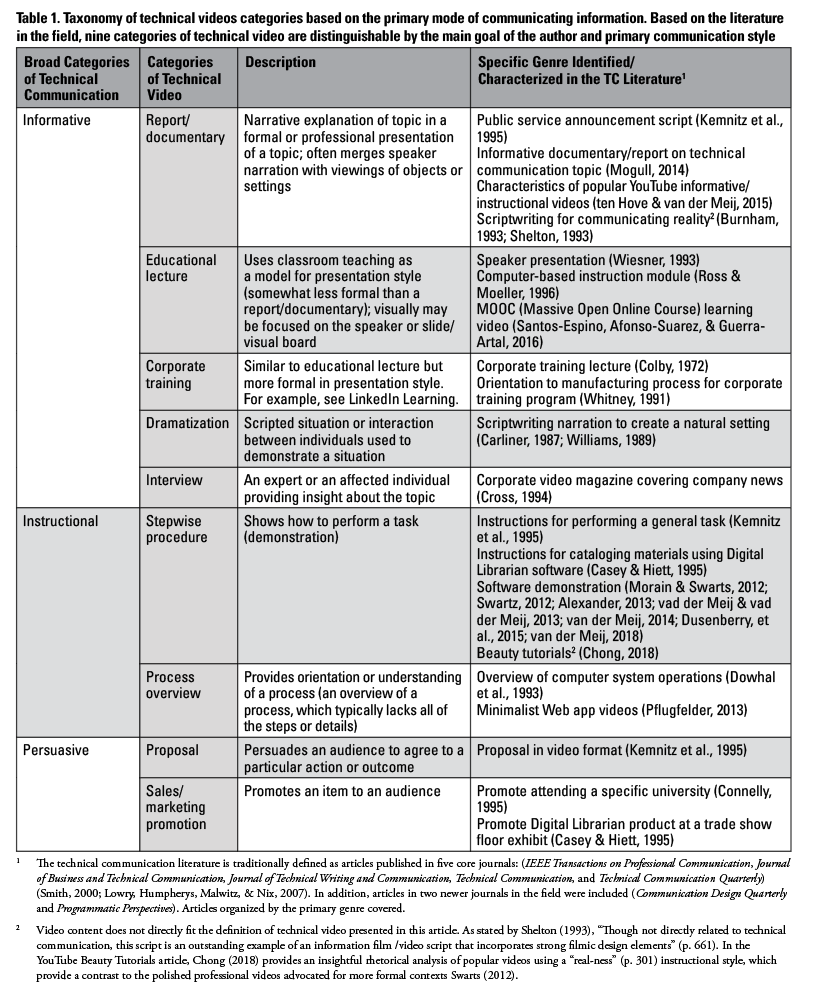 Corporate technical videos are near exact execution of the storyboards and scripts. The precise filming of the written content occurs for multiple reasons. First, for technical videos in many industries, the production personnel (directors, camera operators, actors, and graphic designers) are hired for their respective talents and do not have the subject-matter expertise to change or recreate the vision specified by the writer or writing team. Directors in this context are more appropriately considered project managers, who execute the written genres provided by the technical writers. Furthermore, technical videos often require management approval for content, which is based on the written genres, before moving to the expensive and time-consuming production phase. This evaluation also protects technical communicators and organizations from potential legal ramifications that may arise from misrepresentation of individuals or information, or copyright infringement. Thus, any significant change to the content after management approval would be inconsistent with the expectations of management. Finally, the writers of technical videos (typically a group of individuals)—as well as the managers necessary for approval of revised content—are rarely present throughout the filming, animation, sound production, and final editing stages. Therefore, writers of technical video in professional and formal contexts must clearly visualize and thoroughly communicate their vision for the final video as the concept develops through these four written genres for the planning and writing of the audial and visual content.
Corporate technical videos are near exact execution of the storyboards and scripts. The precise filming of the written content occurs for multiple reasons. First, for technical videos in many industries, the production personnel (directors, camera operators, actors, and graphic designers) are hired for their respective talents and do not have the subject-matter expertise to change or recreate the vision specified by the writer or writing team. Directors in this context are more appropriately considered project managers, who execute the written genres provided by the technical writers. Furthermore, technical videos often require management approval for content, which is based on the written genres, before moving to the expensive and time-consuming production phase. This evaluation also protects technical communicators and organizations from potential legal ramifications that may arise from misrepresentation of individuals or information, or copyright infringement. Thus, any significant change to the content after management approval would be inconsistent with the expectations of management. Finally, the writers of technical videos (typically a group of individuals)—as well as the managers necessary for approval of revised content—are rarely present throughout the filming, animation, sound production, and final editing stages. Therefore, writers of technical video in professional and formal contexts must clearly visualize and thoroughly communicate their vision for the final video as the concept develops through these four written genres for the planning and writing of the audial and visual content.
Video project proposal (program needs analysis and creative concept)
The first written genre often created for technical videos in industry, the video project proposal, specifies the purpose, content, video style, delivery platform, budget, and project timeline (Chu, 2002; Dowhal et al., 1993; Sweetow, 2017). The video project proposal is used within the writing team to reach a consensus for the video project concept and is also often used by management for review and approval prior to further investment in the video development.
While content planning stages are familiar to technical communicators as analogous steps parallel the writing process of technical documents, the stakes for creating technical videos are significantly higher than for written text. From a resource perspective, technical videos in industry range in cost from $1,300 to $10,000+ (Digital Information World, 2019). The lower range of the scale includes in-house (or “DIY”) projects with consumer-grade video production equipment, whereas the upper range is the typical cost for outsourced production that includes industry-grade equipment, editing, and personnel (actors/talent, camera operators, and post-production personnel). Although many technical videos are produced on the lower range of the scale, with some conventional steps of filming, editing, and distribution enabled by easy-to-use technology (such as low-cost animation software), investment alone is not the only reason to thoroughly plan the video content. An often-underappreciated dimension of technical video planning is filming all the necessary content during a single opportunity (including multiple retakes) to ensure quality footage rather than reworking the concept at the last possible opportunity. Typically, video directors focus on filming multiple retakes of a scene during the same block of time since recreating a scene at a later time with precisely the same visual and audial foreground and background is nearly impossible. The point is that technical communicators planning a technical video—particularly those new to the medium—should invest more upfront effort and time in the rhetorical evaluation and planning genres for the video so that the complex acting and staging can be the focus at the filming stage and all the necessary footage is filmed at each location. Due to the complexity and expense necessary for the filming stage, the planning stages for technical video are more important than for other media (such as print and webpages) because each scene of a video is typically filmed on a single date and the recorded content cannot be easily replicated or changed later. For technical video, the “editing” phase is almost always limited to “cutting and pasting” the filmed video clips together (Spannaus, 2012)—not changing content at the last minute to revise the message of the communication.
For individuals new to planning and writing technical videos, analyzing the strengths and weaknesses of existing videos on the topic (or similar topics) will help to conceptualize different parts of the communication, especially by identifying effective content and presentation styles. As an example, a team of technical writers from IBM who created a technical video for the first time highlighted that they analyzed many technical videos before they began writing—in which they not only evaluated the communication style of the audio-visual medium for similar technical content but also, as they stressed, “learned what not to do” as a way to avoid possible mistakes (Dowhal et al., 1993, p. 68). A recommended practice is to find two to three “good” technical videos on a similar topic and then evaluate each technical video, possibly using the list of questions in Figure 1. The purpose of identifying “good” technical videos, in addition to the “bad” ones, is to analyze models of effective communications and have useful examples to guide the visual and verbal/audial elements of the communication.
After evaluating existing technical videos on the topic, the first part of the proposal is to specify the technical content and style of a technical video. An example of the technical content of video project proposal integrates a “program needs analysis” (the goal and content) and includes a plan for the “creative concept” (or style) (DiZazzo, 2004), as provided in Figure 2. In this video project proposal, technical communicators identify the communication goals and rhetorical context (purpose, audience, scope, and communication setting) as well as specify the “creative concept” or the presentation style so that all individuals agree on the direction of the communication before planning the details (Connelly, 1995; DiZazzo, 2004; Floyd, 1987). Of particular note, the planning documentation for technical video includes both the informative and motivational (or affective) objectives of the communication, which are the intended outcome(s) that the video will have on the audience (Connelly, 1995; DiZazzo, 2004).
Depending on the needs and expectations of writers and management, video project proposals may also include a content outline of the entire video (Connelly, 1995; DiZazzo, 2004; Floyd, 1987). Although instructional videos have a relatively standard organization for each genre, a content outline may be particularly useful for determining the ultimate rhetorical effectiveness of the video. As detailed in Figure 3, the conventional structure for an informative video uses a structure similar to an oral presentation (DiZazzo, 2004; Floyd, 1987).
Short and less formal videos may have a simpler structure, a problem-to-solution structure (DiZazzo, 2004), which is the foundation of cinematic storytelling and can be developed from a sentence starting with, “It’s about someone who” needs or does the following in a specific context (Leipzig, Weiss, & Goldman, 2016, p. 27). For such dramatizations, writers may substitute a formal outline with a scene-by-scene narrative description of the video, which is called a “treatment” (DiZazzo, 2004; Griese, 1992). Treatments are written as stories in third person and present tense, as if describing each scene of a video as it occurs in real time (Figure 4). Like creative writing, the treatment is filled with affective terms and descriptions of settings, which further enhances learning through affective storytelling in video. Although many technical videos emphasize direct presentation styles, dramatizations may be incorporated into these videos as short vignettes to integrate the information from a realistic situation and encourage contextual learning. Depending on the audience and length of the video, some more complex dramatizations may resemble the prototypical three-act structure of a play, which engage a more general audience but take more time to setup and resolve a plot.
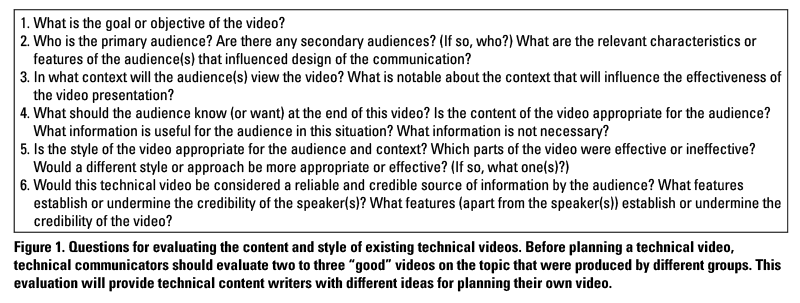
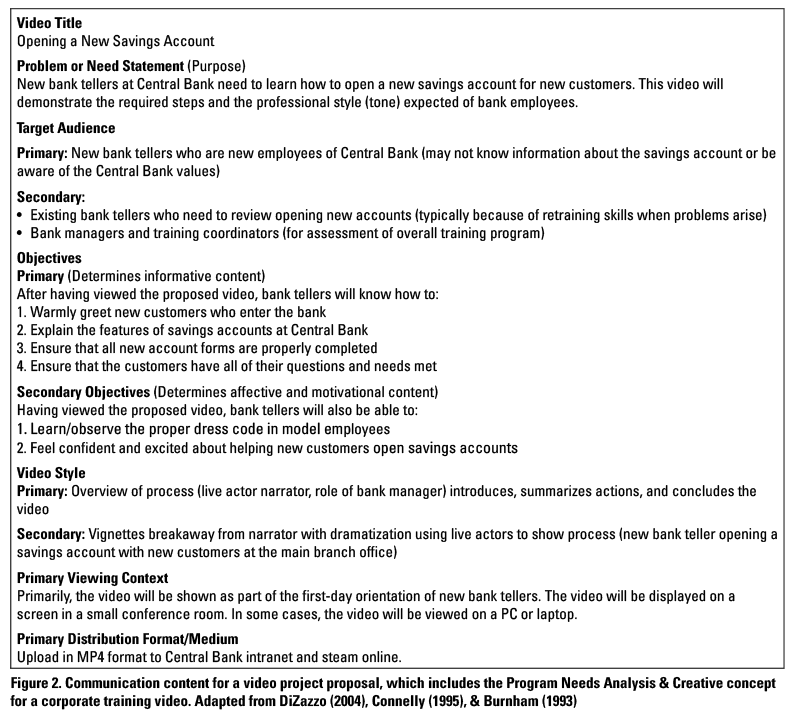 Storyboard
Storyboard
After the video proposal is reviewed and finalized, the next step for many video projects is to develop a storyboard. A storyboard, similar to a comic book, is a visual, scene-by-scene sequence of drawings outlining the “story” or structure of the video. Often, storyboards are annotated with the key dialogue and major directions for the camera operator and actors to help develop the progression of the video. As emphasized by a professional technical video developer, the storyboard helps technical writers focus on the visual communication as they conceptualize the video. In particular, the video developer stated,
Film/video scripting is, in fact, visual communication designing—not writing. “Don’t write, draw,” is an ideal maxim for you to follow in your script-designing endeavors. That is, don’t write a script: Draw a storyboard…Thus, the video script is designed rather than written. And by design I mean visual planning that encodes the message to be transmitted into meaningful kinetic visuals with sound in only a supporting role. (Shelton, 1993, p. 658)
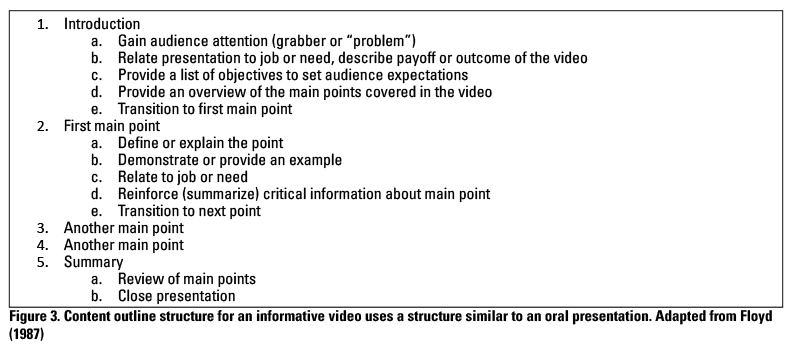

Visualization, or imagining and creating a visual communication rather than a text-based, narrative communication, is one of the less familiar and challenging steps in the process for those trained in technical writing (Floyd, 1987; Gillette, 2005; Shelton, 1993). Technical writers, as well as students and instructors, are generally more familiar with communicating thoughts through words—often as the primary or sole communication channel—even if not the best channel for the information being communicated (Dowhal et al., 1993; Floyd, 1987; Gillette, 2005). Yet, some trends in visual communication planning are underway in academic institutions. For example, the librarians overseeing new media spaces at the University of Pennsylvania noted significant increases in the popularity of new media assignments (specifically video) to educate and engage the “YouTube Generation” (Vedantham & Hassen, 2011). Thus, increasing numbers of technical communicators in the 21st century are using video to both “show and tell” (Chilcutt & Brooks, 2019, p. 81). Importantly, effective “showing” through the visual communication channel improves audience engagement and retention of the communication, as well as improves the perceived credibility of the speaker (Fish, Mun, & A’Jontue, 2016; Gibson, Hodgetts, & Blackwell, 1990; Saleh, 2011). However, the visual communication elements must be as carefully considered as the written words. For example, in a special section on technical video production in Technical Communication, Carliner (1987) noted that, “Beginning scriptwriters often rely too heavily on words or overuse audiovisual gimmicks” (p. 11). Rather than using decorative visuals or media “gimmicks,” the most effective technical videos show what can (and should) be shown—and supplement this visual content with contextually appropriate narration that highlights, describes, or expands on the main points being shown (Carliner, 1987; Floyd, 1987; Shelton, 1993). As stated by a professional technical video developer, for video,
Seeing is the key. We are a visual species. Practically all the information we receive every day comes through our eyes—the primary receptor. Sounds play a strictly subordinate role in the reception of information in everyday life for most of us. And spoken words should play a similar subordinate role in our films. (Shelton, 1993, p. 659)
While considering the images, also consider using various camera angles, camera zoom, superimposed text and graphics, and color to highlight important visual information (Carliner, 1987). Notably, these visual strategies are carefully planned to focus the audience’s attention on key content (Table 2). Visual design strategies for refocusing attention should be based on the content and clearly defined audience needs rather than loosely defined reasons (such as “for interest”) because such vague, nonspecific rationale lacks information-grounded rhetorical intent and may indicate that a dull video concept may be lacking effective visual communication and substituting undefined decorative visuals or “gimmicks” to engage the audience. Such “overuse [of] audiovisual gimmicks” (Carliner, 1987, p. 11) is analogous to the concept of “chartjunk” introduced by Tufte (2001) for visual elements on a graph that were intended to be decorative but are unnecessary—or ineffective—in communicating information to the audience (Few & Edge, 2011).
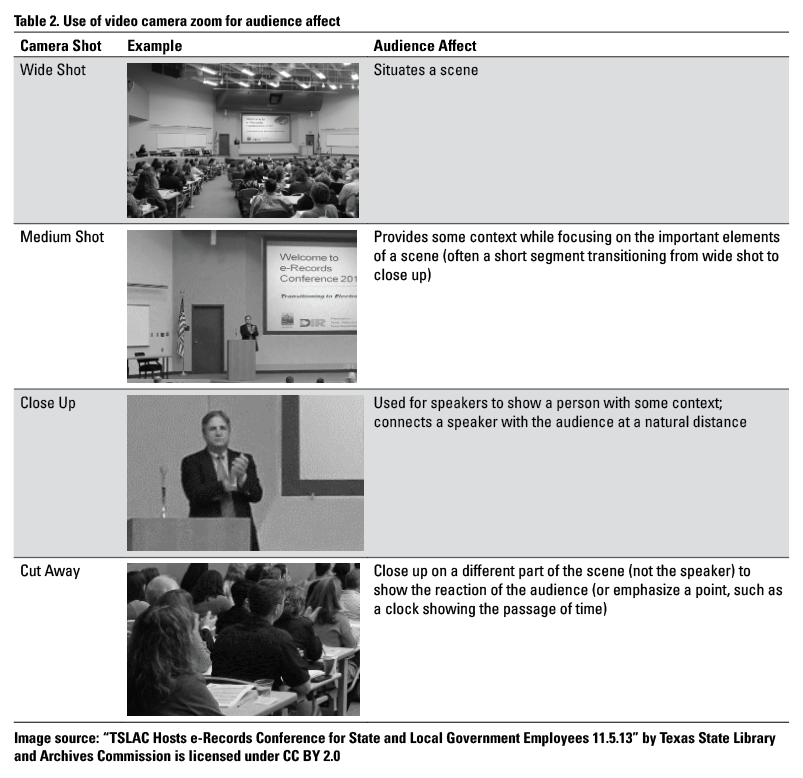 In addition to visual communication, technical writers must consider the added dimensions of motion and time, which are inherent in the dynamic video medium (Carliner, 1987; Gillette, 2005). The most effective videos are not slideshows of static images (a “montage”), but rather uses the camera to guide the audience’s eye and attention through scenes and content (Shelton, 1993). The goal of video is to provide appropriately paced visual content to accompany the narrative, which is developed through the flow of imagery to create a visual “story” in which the main points may be deciphered even without the audio (Shelton, 1993). Often, dynamic visual communication is one of the most challenging aspects for new video scriptwriters trained in print. In one case, a team of technical writers creating a technical video at IBM emphasized that,
In addition to visual communication, technical writers must consider the added dimensions of motion and time, which are inherent in the dynamic video medium (Carliner, 1987; Gillette, 2005). The most effective videos are not slideshows of static images (a “montage”), but rather uses the camera to guide the audience’s eye and attention through scenes and content (Shelton, 1993). The goal of video is to provide appropriately paced visual content to accompany the narrative, which is developed through the flow of imagery to create a visual “story” in which the main points may be deciphered even without the audio (Shelton, 1993). Often, dynamic visual communication is one of the most challenging aspects for new video scriptwriters trained in print. In one case, a team of technical writers creating a technical video at IBM emphasized that,
Writers must have visual and aural sensitivity, so that their ideas can be translated into a dynamic (as opposed to static) presentation. Before you actually start to write the script, you should have a structure in place for the entire video [i.e., the storyboard]. (Dowhal et al., 1993, p. 64)
To begin to develop a sense of pacing in storytelling, one of the most effective approaches is to evaluate existing technical videos for the visual composition “storyline” and the pace of information (Gillette, 2005). Then, the dynamic visual narrative is developed in the storyboard, as discussed below.
Creating a storyboard involves visualizing the final video on paper and sketching the relevant visual communication elements necessary in each scene. Individual sketches of each planned shot are organized into panels, which may be placed on a single page (see Figure 5) or include with additional detail to span several pages (see Figure 6). In Figure 5, for example, the complete storyboard for a visitor registration website is illustrated scene-by-scene through the progression of a comic book-like visual storyline with supplemental notes to guide the narration during the scriptwriting phase. Although this one-page storyboard follows a comic-book format, more detailed storyboard templates (like those in Figure 6) include a summary of narration/dialogue below each pane along with notes that annotate the sketch, such as the major camera angles or actions to explain additional visual elements or actions for the shot.
Notably, storyboarding does not require advanced drawing skills, but rather stick drawings and basic shapes representing objects are sufficient to convey the visual concept from the mind of the author to the filmmaker so that the final scene can be discussed and then created on video (Stoller, 2008). One of the more common obstacles associated with storyboarding is that some novice scriptwriters are overly concerned with the quality of the sketch and, in some cases, try to create a collage of images from online repositories rather than sketch (i.e., create and develop) their own visual plan (Mogull, 2014). As further described, some novice scriptwriters during the storyboarding phase
spent excessive amounts of time online browsing for available images that related to the content. Often, those [resulting] videos turned into visual collages of stock photos that were loosely tied to the narration and rarely was an effective use of the visual channel. In such cases, the visual channel was essentially “noise” and information was only communicated through narration. (p. 352)
To avoid such obstacles, novice scriptwriters are encouraged to create simple stick drawings on a blank template with only relevant sketches of objects for context (Mogull, 2014). From my experience teaching technical writing students, I have found that many students who integrate images from other sources into storyboards generally lack concrete visual communication planning and had limited relevancy of images that were found from the Web or when using basic storyboarding software with limited options. In contrast, students drawing storyboards by hand were focused more on developing a cohesive, pane-by-pane visual storyline as they conceptualized the video and were more cognizant of the resources that they will have available for filming the final video. At least anecdotally, hand drawing a storyboard or using a full pallet of options from online storyboarding software seems to help novice scriptwriters plan videos more effectively through the visual communication channel.
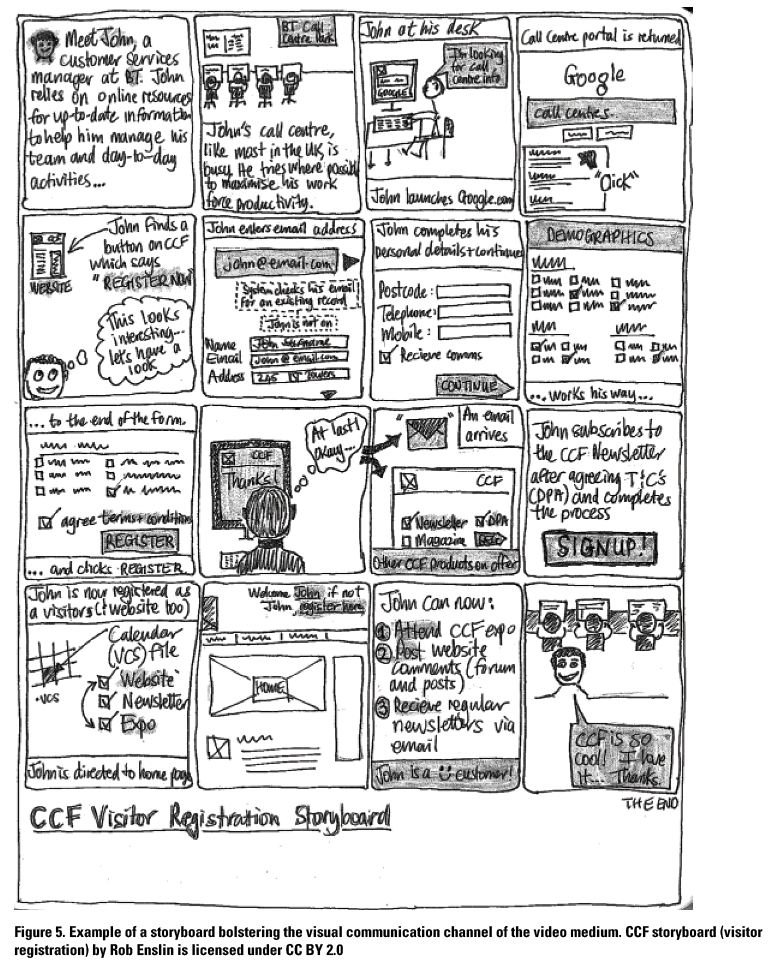
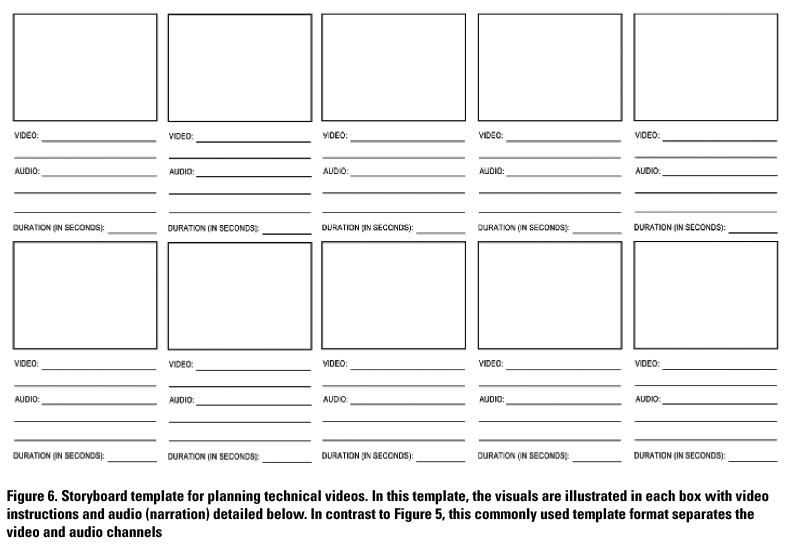 The “shot composition,” or the collection of the visual panes in the storyboard, ultimately provides the full content of the planned video from the opening title screen to closing frame with the concluding message (Blazer, 2016). The “framing” of each scene focuses on the relevant people, objects, text, and graphics throughout the planned video. The “staging,” or the background setting, should also be developed during the storyboarding phase as it provides appropriate context for the presentation or storyline. Typically, the background includes the location(s) and objects that are necessary to effectively situate the video. However, the background setting requires a careful balance to avoid an underdeveloped background (a “dead zone” around the speakers or objects) or, at the other end of the scale, excessive detail or activity that would compete with the speaker or objects in the foreground and distract the audience from the primary message. By critically assessing the foreground and background of other technical videos, those new to the medium can develop a sense for achieving a balance between the visual message and limiting excess visual noise.
The “shot composition,” or the collection of the visual panes in the storyboard, ultimately provides the full content of the planned video from the opening title screen to closing frame with the concluding message (Blazer, 2016). The “framing” of each scene focuses on the relevant people, objects, text, and graphics throughout the planned video. The “staging,” or the background setting, should also be developed during the storyboarding phase as it provides appropriate context for the presentation or storyline. Typically, the background includes the location(s) and objects that are necessary to effectively situate the video. However, the background setting requires a careful balance to avoid an underdeveloped background (a “dead zone” around the speakers or objects) or, at the other end of the scale, excessive detail or activity that would compete with the speaker or objects in the foreground and distract the audience from the primary message. By critically assessing the foreground and background of other technical videos, those new to the medium can develop a sense for achieving a balance between the visual message and limiting excess visual noise.
Logistically, the number of frames of a storyboard does not have a preestablished minimum or maximum, but is based on the length of the video and the need to shift the perspective of the camera. Generally, the guideline for adding additional frames to a storyboard is to create a new sketch each time something different is to be shown—a different person, object, camera angle, or setting. However, technical video storyboarding also requires attention to any excessively long camera shot on a speaker, or object, since changing the camera angle or transitioning between speaker and object will help avoid relatively unchanging visual scenes that lack any novel visual information. Furthermore, there is not any fixed time length that each sketch translates into video—rather, some scenes will be longer, and some might be very brief. The exact filming time for each panel of the storyboard depends on the content and the audience’s need for appropriate pacing of the information. In some cases, the length of the storyboard may indicate whether a video may be visually “dull” (if a storyboard has too few scenes) or too chaotic for the running time (if a storyboard has excessive scenes for the amount of content). For example, a storyboard with 3 sketches and a running time of 10 minutes may suggest a lack visual development whereas 20 sketches for a 30 second video may be visually overwhelming.
Storyboards and scripts are organized into scenes and shots, which are used by filmmakers to plan the filming stage. By definition, a “scene” is any single physical location where a video is filmed. Thus, short videos may have only one setting or scene. On the other hand, “shots” designate each change in the camera location (the viewpoint) or a shift to or from a cutaway image of an object, graphic, or text. For storyboard and script development, both scenes and shots are numbered sequentially based on the final order of viewing, with the renumbering of shots resetting to 1 for each new scene. This numbering system of shots and scenes is important for the final video editing process because filming of videos is typically based on location and camera angle so the actual video is rarely filmed chronologically. Specifically, all shots from a particular camera location (or perspective) are recorded before the cameras, lighting, and sound equipment are moved to capture a different shot. Such repositioning of equipment (and the setup of scenes) is even more laborious when changing physical locations. As a result, the shots and scenes from the storyboard and script are usually reordered immediately prior to filming in the “shot list” to make the video recording phase efficient and consistent with settings and ambient noise. Therefore, after the storyboard is complete, the visual progression through the shots and scenes should be reviewed for continuity of style and spatial orientation to ensure that objects and the settings are consistently positioned and motion follows physical laws (Blazer, 2016; Stoller, 2008). Typically, the storyboard review phase is much like reorganizing an outline in that frames are added, deleted, moved, or changed during the process to finalize the final structure of the video storyline before moving to the more detailed and laborious phase of scriptwriting.
Script
Once the storyboard is finalized, the process of writing the script is relatively straightforward since the structure or storyline of the video is already established and the writers then focus on the exact wording and visual elements to complete the video plan prior to the filming stage (Floyd, 1987). Notably, the writing style for video—even technical video—is different than other forms of technical writing. From a rhetorical perspective, the video medium serves as an important part of the rhetorical triangle that influences the writing style (Kinneavy, 1971; Gorrell, 1997). In particular, technical writers write the narration or dialogue that is appropriate for the “context” of the video format.
Logistically, the format of a script may be organized into one or two columns. The two-column format is a common and useful organizational tool for technical video scripts in industry because the two-column format clearly distinguishes the video and audio channels (Figure 7), which also helps ensure that scriptwriters are considering both communication channels in parallel. Typically, scriptwriters focus on the speech of actors and off-screen narration (called a voiceover), although video scripts also provide substantially more visual direction than the storyboard (see Table 3) to describe the visual scene, camera direction, speaker vocal emotive inflections, and audio track (music) style. Notably, the visual communication channel develops further alongside development of the narration or dialogue.
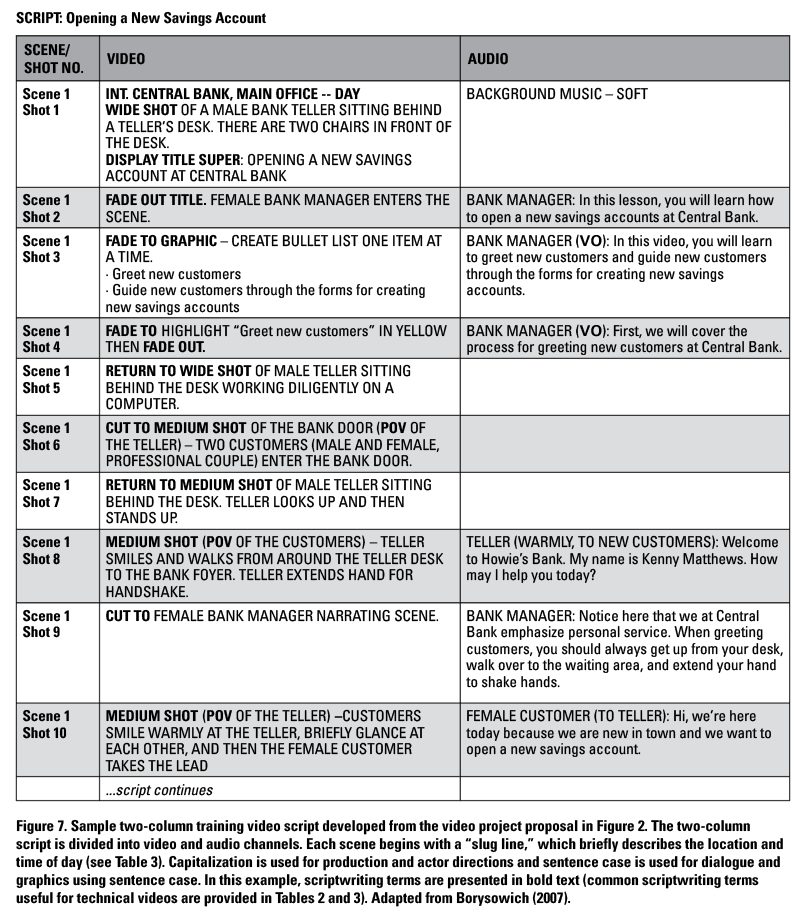
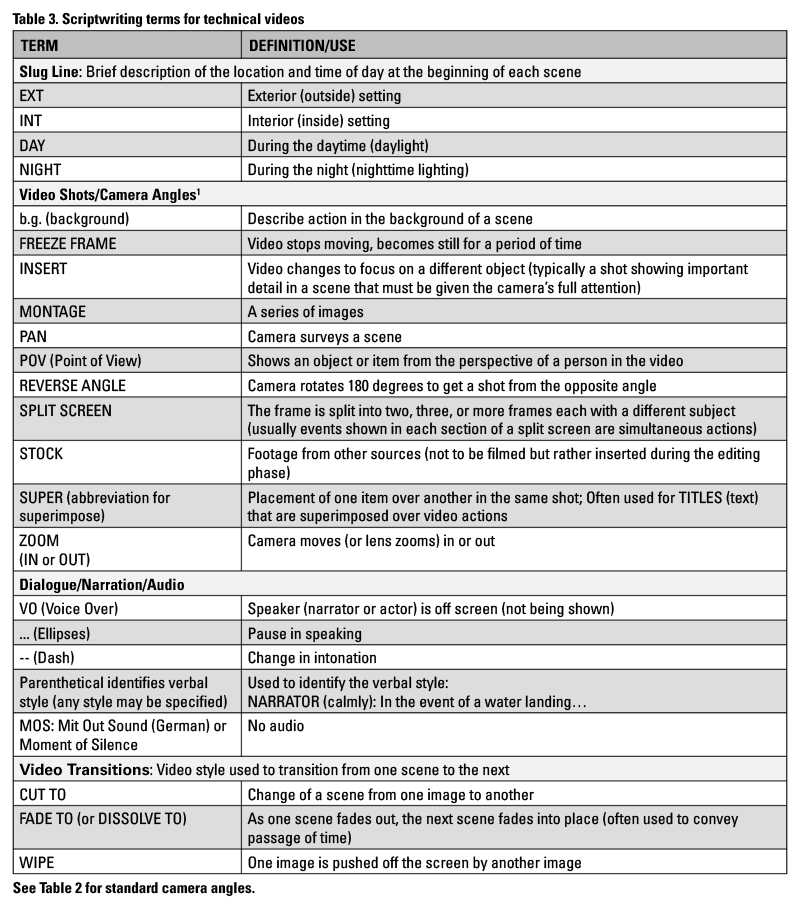
As mentioned previously, the narration of technical videos is subordinate to the visual communication (Shelton, 1993). Notably, the style of writing for video (even technical videos) is more colloquial and may not be entirely grammatically correct as sentence fragments and other less formal speaking styles are commonly distributed throughout a video as the audio annotates the visual communication. A useful maxim provided by scriptwriters is to “write for the ear not the eye” (Shelton, 1993, p. 660). In other words, read the narration aloud alongside each visual shot to ensure that both are communicating contextually. More specifically, one of the greatest distinctions between scriptwriting and other forms of technical writing is the style and formality. As Shelton (1993) explains,
Film/video script designing is especially tough for [technical] writers…. Writers write words to be read in some variation of the print medium. And these words are usually read silently and privately. Conversely, designing a video script deals with kinetic visuals to be seen, and words and other sounds to be heard. (p. 658)
A team of technical writers at IBM agreed, with their recommendation to,
Read it aloud, as the written word and the spoken word are different. We discovered that we modified our audio script as we read it aloud to others at our status meetings. (Dowhal et al., 1993, p. 65)
In general, video is a less formal than print with narration and dialogue written in an appropriate conversational style—the way that people naturally speak to other people in the particular context (Brar & van der Meij, 2017; Griese, 1992; Rhodes, 2018; Shelton, 1993). Video script narration and dialogue should have clear and simple language, short sentences and simple sentence construction, and relatively short descriptions and explanations when compared to print counterparts (Burger, 2015; Rhodes, 2018). In many cases, a final script is not grammatically correct or entirely coherent as a stand-alone, written communication without referring to the visual channel because the audial channel complements the visual communication, which should be the primary communication channel (Shelton, 1993). Several articles mention that most technical video scripts are “overwritten” or, in other words, contain too many words (Carliner, 1987). Professional technical video scriptwriters emphasize that time seems to move more slowly on video, so information should be delivered at a slightly accelerated pace when compared to normal conversation or presentation format (Williams, 1989). As stated by one scriptwriter,
Viewers are impatient. For this reason, it’s critical that your video get to the point quickly to keep them engaged. Add to that…distractions. They are constantly competing for your viewer’s attention. That’s why efficiency in your video is vital—you don’t want viewers to lose interest. (Burger, 2015, p. 15)
The number of words of a script is highly variable depending on the content, the use of the visual communication channel, and needs of the audience. For example, the typical number of words in a public service announcement is approximately double the number of seconds, with a 30 second public service announcement averaging 60 words (Musburger, 2007). Yet, public service announcements may not be the best example for technical content because public service announcements are relatively simple and limited in scope. In contrast, more technical material requires additional information and, at times, a slower pace so that audiences could process the complexity, details, and less familiar information.
Once the content of the script is finalized, scriptwriters review the style and pace of the narration or dialogue by reading the audio channel aloud and evaluating the message with the original goal of the communication. The style of the video script, unlike many printed technical communications, should be more energetic to engage an audience and maintain their attention (Carliner, 1987). An important element of engaging and maintaining attention is to ensure that video scripts efficiently communicate relevant information at an appropriate pace of delivery and, importantly, avoiding including extra information or “fat” that is unnecessary and may result in loosing audience attention (Burger, 2015, p. 15; Carliner, 1987). The writing style of the audial channel, frequently a new style for technical writers, helps the speakers and actors in a video connect with the audience and keep them engaged. As discussed by a scriptwriter who designs and develops corporate training and marketing videos, reviewing the narration and dialogue in a script is essential before moving into the filming and production phases. Specifically, the scriptwriter states,
Many production qualities are more readily visible than the writing: bad acting, poor lighting, choppy editing, continuity problems, and so forth. Very often, though, a poor program started with a poor script. High-budget programs may look good on first appearance, but a confusing (or missing) message can quickly spoil the program. It does not matter how much a weak script is dressed up, it simply will not work. There is an expression in the field of video production: “Well, maybe we can fix it in post” (post-production). To most video professionals, this adage is a joke. It may fool some, but it certainly will not be an award-winning program…Good writing creates a good foundation that a production team can build on to produce an effective video program. (Griese, 1992, p. 104)
Thus, technical communicators should review and finalize the script (both the verbal and visual communication elements) before progressing to the production phase (which begins by creating the last genre, the “shot list”).
Shot list
The last genre to develop for technical videos is the “shot list,” in which writers reorganize the shots and scenes in a script so that they are grouped by location and camera angle to make the filming stage more efficient and consistent (Figure 8). Notably, the shot list is not a genre for developing novel content, but rather is a tool that will be used by the director and production staff during the filming stage as a checklist to collect all necessary content. Filming videos by location is more time (and resource) efficient because it minimizes setup and relocation of production equipment, while ensuring greater consistency both visually and audibly because the setting remains consistent for all “takes” from the same camera angle and with consistent ambient noise levels (Griese, 1992; Stoller, 2008). Although the shot list and script will be identical in the verbal and visual plan, the shot list may also provide additional logistical information about the locations or setup of scenes so that the director and production staff have all of the information that they need in writing to film the video. The shot list formalizes and solidifies the script by transferring the technical video project from the planning and creation stages to the production phase. In essence, the shot list may be considered the plan, or blueprint, for the production crew to use so that all of the scenes and shots are filmed precisely as intended at each location. A complete shot list, which should be cross-checked by the scriptwriters to ensure that all information is properly transferred, helps ensure that all shots and scenes are setup properly and filmed and that all necessary content will be filmed and available for the video editing phase. For technical video, the editing phase is the phase when the recorded shots are spliced and reordered according to the original script and the final video is prepared for distribution.
CONCLUSION
In this article, four content genres (project proposal, storyboard, script, and shot list) for technical video planning, development, and production are detailed to serve as a guide for practitioners in industry and as curriculum materials for students and instructors. The primary purpose in describing these genres is to provide those trained for other forms of technical writing to have the vocabulary and a set of templates to use for creating technical videos in industry. This discussion of each genre was supplemented with insights from technical writers in industry who were trained primarily for print and developing technical videos as novice scriptwriters. Furthermore, this tutorial provides the “best practices” collected from the literature for creating technical videos, which have been further annotated with insights that arise from watching novice scriptwriters develop these genres. Notably, this article continues to highlight the primary issue of the overreliance of novice scriptwriters on the verbal “telling” of information in their videos rather than the visual communication, or “showing” of information. In conclusion, technical videos draw from and build on the writing and visual communication skills that are the foundations of the field, but the video medium places additional demands for developing engaging, dynamic visual communications in the new medium.
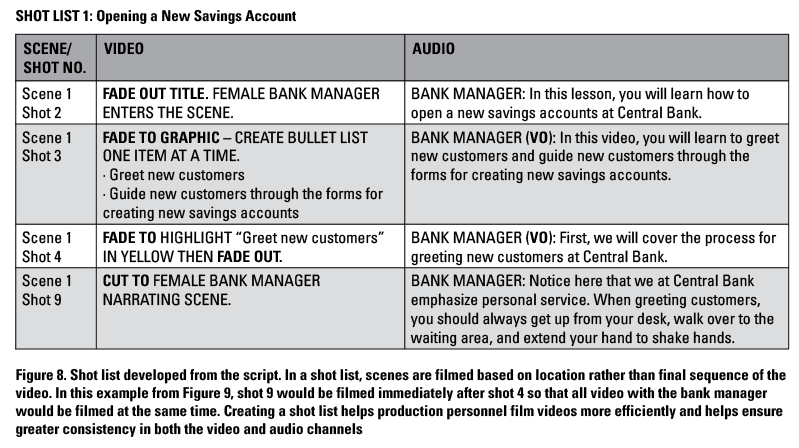
ACKNOWLEDGEMENTS
The author would like to express gratitude for the insightful and constructive recommendations provided by three anonymous peer reviewers as well as the journal editor.
REFERENCES
Alexander, K. P. (2013). The usability of print and online video instructions. Technical Communication Quarterly, 22(3), 237-259.
Allen, A., & Randall, S. (1998). Designing, developing, and marketing multimedia products. Journal of Technical Writing and Communication, 28(2), 207-215.
Blazer, L. (2016). Animated storytelling: Simple steps for creating animation and motion graphics. San Francisco, CA: Peachpit Press.
Borysowich, C. (2007). Sample Training Video Script. Retrieved from https://www.toolbox.com/tech/enterprise-software/blogs/sample-training-video-script-080407
Bradford, A. N. (1987). Writing training information: a comparison of books, online tutors, and videotapes. Journal of Technical Writing and Communication, 17(2), 115-127.
Brar, J., & van der Meij, H. (2017). Complex software training: Harnessing and optimizing video instruction. Computers in Human Behavior, 70, 475-485.
Burger, L. (2015). 7 secrets of engaging online video scripts. Marketing Health Services, 35(4), 14-15.
Burnham, L. D. (1993). A film/video script: The scarf: Perennial fashion statement. Technical Communication, 40(4), 664-665.
Carliner, S. (1987). Audiovisual words: The scriptwriter’s tools. Technical Communication, 34(1), 11-14.
Casey, B., & Hiett, M. (1995). Applying multimedia to technical information. In 1995 IEEE International Professional Communication Conference. IPCC 95 Proceedings. Smooth Sailing to the Future (p. 57-61). IEEE.
Chilcutt, A. S., & Brooks, A. J. (2019). Engineered to Speak: Helping You Create and Deliver Engaging Technical Presentations. John Wiley & Sons.
Chong, F. (2018). YouTube beauty tutorials as technical communication. Technical Communication, 65(3), 293-308.
Chu, S. W. (2002). Digital Production of Corporate and Industrial Videos: A Primer. Intercom, 49(1), 18-24.
Colby, J. B. (1972). Video-taped technical communication. Journal of Technical Writing and Communication, 2(2), 101-108.
Connelly, J. O. (1995). From print to pictures. Technical Communication, 42(1), 141-147.
Cross, G. A. (1994). Recontextualizing writing: Roles of written texts in multiple media communications. Journal of Business and Technical Communication, 8(2), 212-230.
Digital Information World. (2019, March 30). How much does video production cost in 2019 (Infographic). Retrieved from
https://www.digitalinformationworld.com/2019/03/how-much-does-a-video-cost-infographic.html
DiZazzo, R. (2004). Corporate media production (2nd ed.). Burlington, MA: Focal Press.
Dowhal, D., Bist, G., Kohlmann, P., Musker, S., & Rogers, H. (1993). Producing a video on a technical subject: a guide. IEEE Transactions on Professional Communication, 36(2), 62-69.
Dusenberry, L., Hutter, L., & Robinson, J. (2015). Filter. Remix. Make. Cultivating Adaptability Through Multimodality. Journal of Technical Writing and Communication, 45(3), 299-322.
Few, S., & Edge, P. (2011). The chartjunk debate. Visual Business Intelligence Newsletter, June 1-11.
Fish, K., Mun, J., & A’Jontue, R. (2016). Do Visual Aids Really Matter? A comparison of student evaluations before and after embedding visuals into video lectures. Journal of Educators Online, 13(1), 194-217.
Floyd, S. (1987). Visualization: The key to effective scriptwriting. Technical Communication, 8-10.
Gibson, J. W., Hodgetts, R. M., & Blackwell, C. W. (1990). Engineering visual aids to enhance oral and written communications. In IPCC 91 Proceedings The Engineered Communication (Vol. 1, pp. 194-198). IEEE.
Gillette, D. (2005). Looking to cinema for direction: Incorporating motion into on-screen presentations of technical information. Technical Communication, 52(2), 138-155.
Gorrell, D. (1997). The rhetorical situation again: Linked components in a Venn diagram. Philosophy & Rhetoric, 30(4), 395-412.
Griese, L. (1992). Writing for video. In A. R. Richardson (Ed.), Corporate and organizational video (pp. 103-117) New York, NY: McGraw-Hill.
Hart, G., & Proulx, M. (2005). Creating professional-quality training videos. Intercom, 52(2), 18-22.
Kemnitz, C. F., Jeansonne, J., Kim, Y., Pirie, C., Shafer, K., Walker, T. B., & Zambon, T. (1995). Technical scriptwriting: A seminar approach to learning. Technical Communication, 42(3), 467-473.
Killingsworth, M. J., & Gilbertson, M. K. (1992). Signs, genres, and communities in technical communication. Amityville, NY: Baywood.
Kinneavy, J. L. (1971). A theory of discourse: The aims of discourse. Hoboken, NJ: Prentice-Hall.
Leipzig, A., Weiss, B. S., & Goldman, M. (2015). Filmmaking in action: Your guide to the skills and craft. Boston, MA: Macmillan Higher Education.
Lowry, P. B., Humpherys, S. L., Malwitz, J., & Nix, J. (2007). A scientometric study of the perceived quality of business and technical communication journals. IEEE Transactions on Professional Communication, 50(4), 352-378.
Martin, N. A., & Martin, R. (2015). Would you watch it? Creating effective and engaging video tutorials. Journal of Library & Information Services in Distance Learning, 9(1-2), 40-56.
Mogull, S. A. (2014). Integrating online informative videos into technical communication service courses. IEEE Transactions on Professional Communication, 57(4), 340-363.
Morain, M., & Swarts, J. (2012). YouTutorial: A framework for assessing instructional online video. Technical Communication Quarterly, 21(1), 6-24.
Musburger, R. B. (2007). An introduction to writing for electronic media: Scriptwriting essentials across the genres. Waltham, MA: Focal Press.
Northcut, K. M., & Brumberger, E. R. (2010). Resisting the lure of technology-driven design: Pedagogical approaches to visual communication. Journal of Technical Writing and Communication, 40(4), 459-471.
Pflugfelder, E. H. (2013). The minimalist approach to online instructional videos. Technical Communication, 60(2), 131-146.
Rhodes, D. (2018). 6 steps to a strong video script. Administrative Professional Today, 44(9), 5.
Ross, S. M., & Moeller, E. W. (1996). Multimedia and hypermedia CBI: A multidisciplinary review of research on early design stages. Journal of Business and Technical Communication, 10(4), 428-460.
Saleh, T. A. (2011). Testing the effectiveness of visual aids in chemical safety training. Journal of Chemical Health & Safety, 18(2), 5-10.
Santos-Espino, J. M., Afonso-Suárez, M. D., & Guerra-Artal, C. (2016). Speakers and boards: A survey of instructional video styles in MOOCs. Technical Communication, 63(2), 101-115.
Shelton, S. M. (1993). Script design for information film and video. Technical Communication, 40(4), 655-664.
Smith, E. O. (2000). Strength in the technical communication journals and diversity in the serials cited. Journal of Business and Technical Communication, 14(2), 131-184.
Spannaus, T. (2012). Creating video for teachers and trainers: Producing professional video with amateur equipment. San Francisco, CA: John Wiley & Sons.
Stoller, B. M. (2008). Filmmaking for dummies. Hoboken, NJ: John Wiley & Sons.
Swarts, J. (2012). New modes of help: Best practices for instructional video. Technical Communication, 59(3), 195-206.
Sweetow, S. (2016). Corporate video production: Beyond the board room (and out of the bored room) (2nd ed.). New York, NY: Routledge.
ten Hove, P., & van der Meij, H. (2015). Like it or not. What characterizes YouTube’s more popular instructional videos? Technical communication, 62(1), 48-62.
Thralls, C. (1991). Bridging visual and verbal communication: Training videos and written instructional texts. Journal of Technical Writing and Communication, 21(3), 285-306.
Tufte, E. R. (2001). The visual display of quantitative information (vol. 2). Cheshire, CT: Graphics Press.
van der Meij, H. (2014). Developing and testing a video tutorial for software training. Technical Communication, 61(2), 110-122.
van der Meij, H. (2018). Cognitive and motivational effects of practice with videos for software training. Technical Communication, 65(3), 265-279.
van der Meij, H., & van der Meij, J. (2013). Eight guidelines for the design of instructional videos for software training. Technical Communication, 60(3), 205-228.
Vedantham, A., & Hassen, M. (2011). New media: Engaging and educating the YouTube generation. Journal of Learning Spaces, 1(1). Retrieved from http://libjournal.uncg.edu/jls/article/view/218
Whitney, M. A. (1991). Time to make the donuts: The role of video in corporate technical training. IEEE Transactions on Professional Communication, 34(1), 38-41.
Williams, W. W. (1989). Scriptwriting—Don’t slip on the banana peels. Technical Communication, 201-205.
Wiesner, P. (1993, October). Video production and technical education. In Proceedings Professional Communication Conference The New Face of Technical Communication: People, Processes, Products’ (pp. 208-212). IEEE.
ABOUT THE AUTHOR
Scott A. Mogull is an associate professor in the Technical Communication Program at Texas State University. Since 2008, he has been on the editorial board of the journal Technical Communication Quarterly. His research focuses on technical content marketing and the commercialization of technology. Prior to entering academia, he spent 8 years in the biotechnology and biodefense industries, where he wrote and oversaw the production of technical videos. He may be reached by email at mogull@txstate.edu.
Manuscript received 30 September 2020, revised 16 November 2020; accepted 20 November 2020.



